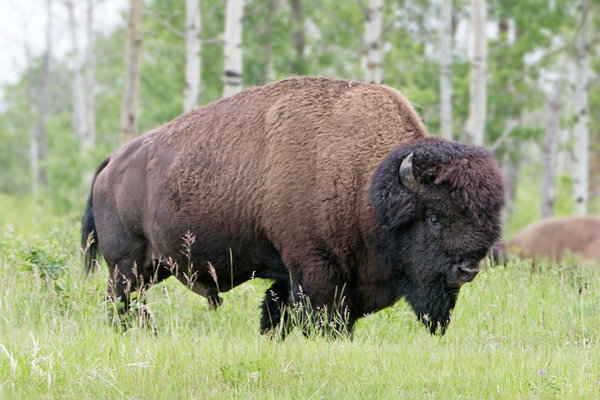
Mistawasis First Nation leads project to conserve Sturgeon River Plains Bison population
“we believe that we need the buffalo beside us in order to properly define ourselves as Nêhiyawak (Cree people).”
– Anthony Blair Dreaver Johnston
Anthony Blair Dreaver Johnston has been advocating for years to revive an endangered bison herd in Prince Albert National Park.
He’s from Mistawasis First Nation, which is about an hour west of Prince Albert. It’s part of the Cree First Nations band government Mistawasis Nêhiyawak, translating to ‘Big Child’ and ‘Cree People.’
Johnston’s community recently received funding from the federal government to kickstart a pilot project for conservation of the Sturgeon River Plains Bison herd. The herd spends most of their time in the southwest corner of the national park.
The initiative is one of 22 First Nations-led projects that received funding, totalling to $6.4 million.
Mistawasis will be training and hiring people—called ‘guardians’ or ‘stewards’—to be on the land sharing stories of the bison, as well as facts about the declining population to anyone they may find in the area, especially hunters.
“In many ways we have to relearn the nature of the animal,” said Johnston, explaining that it starts with youth.
He said they’ll be working with non-governmental organizations, landowners and municipalities, for example, to spread awareness of the bison.
“We hear certain terms such as stakeholders, rights holders through various discussions recently. Alongside our partners, we’re looking for a new dictionary and part of that is that in terms of this herd, in terms of land resources, in terms of landscape, we all have responsibility. Our language is starting to change.”
Johnston emphasized that his longterm goal is a multiyear project to conserve and protect land in central Saskatchewan, and to bring the bison back to their reserved land. He checks his email every day hoping to see approval from the Ministry of Environment.
“It was the buffalo that defined us as plains people. So now in the 21st century when we start to talk about ideas around self-determination, self-government, we believe that we need the buffalo beside us in order to properly define ourselves as Nêhiyawak,” he said.
He said the need to conserve the creatures is also about protecting the land. First Nations ancestors saw everything as having a spirit—water, rocks, plants and animals.
“We considered ourselves as human beings to be the weakest spirit because we needed everything else to provide for us,” said Johnston. He explained that not only did the millions of bison provide for ancestors on the great plains, but they showed them how to survive.
The Sturgeon River Plains Bison herd dates back to 1969, when the provincial government released about 50 bison from Elk Island National Park, Alberta in Thunder Hills, which is just north of the Prince Albert National Park. They were then relocated to their current location.
According to a Quebec study released in May, the population hit its high in 2005 with about 500 bison. Now, there’s only about 120 left. The study says this is because of overhunting, disease and predation.
Johnston said he’s been working to conserve the herd long before the study was released, but it gave them “scientific justification” to back up their proposal for the guardians project.
One of Johnston’s partners in the initiative is the Canadian Parks and Wilderness Society (CPAWS) Saskatchewan. Johnston and CPAWS Saskatchewan Executive Director Gord Vaadeland are continuing their work together to see the herd thrive.
Growing up on a ranch near Big River where wild bison would roam, Vaadeland’s curiosity of the animals began at a young age. He even founded the Sturgeon River Plains Bison Stewards, a group of landowners dedicated to protecting the bison.
As he grew up, he also learnt about their significance to First Nations people.
“You’re taught at a high level in school, or at least when I went to school…about buffalo being hunted and all that kind of stuff, but it was all framed in this wonderful thing that was the settling of the great American and Canadian west,” he explained. “For some people that is what it is. For Indigenous people, it was something completely different.”
“What was being done to the buffalo, it really damaged their spirit. It’s a very sad and painful story when you actually start digging deep.”
Vaadeland said that the bison population was declining rapidly during European settlement because of hunting. Ironically, he explained, they’re also being overhunted now—many by First Nations people exercising their Treaty rights.
He hopes the guardians project will decrease hunting of the bison, but not completely.
“Maybe a ban on hunting is not necessarily the answer. We have to significantly reduce the hunting, maybe even stop it for a couple of years, but the long term goal has to sort of be to maintain that kind of a relationship (between the bison and First Nations people).”
Ultimately, Vaadeland sees the conservation of free-roaming bison as an important step to reconciliation.
“It’s really, really important that Indigenous people, First Nations, are playing a real leadership role there and it just provides a real opportunity to reconcile a lot of the wrong that was done and sort of move forward in the spirit of forgiveness.”
Johnston and Vaadeland are presenting at the American Bison Society conference in Santa Fe, New Mexico from October 28 to November 2.
They’re also hoping for approval to speak at the International Union for Conservation of Nature world congress in France in June of next year.
“It’s a lifelong and generational plan to be with the buffalo again,” said Johnston.
“They’re part of our DNA.”

